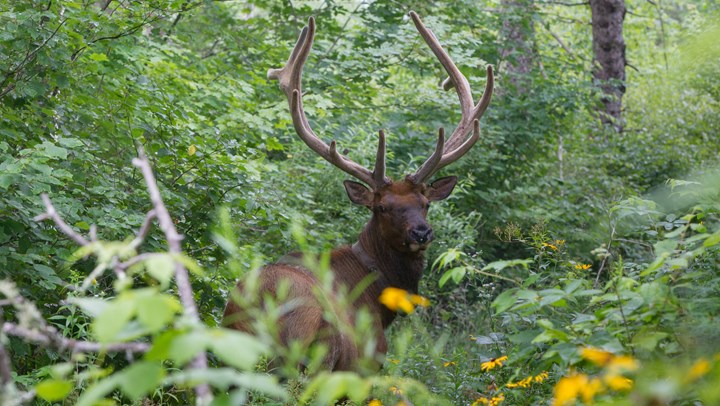
by Keith Crowley - Sunday, September 3, 2017

The sound of a bugling bull elk is one of nature’s grandest sounds, and when you hear that sound in the upper Midwest it’s all the sweeter as it was absent from the state for nearly a century. But the Wisconsin Department of Natural Resources now reports that the state’s northern elk herd has grown by 20 percent, thanks to the trapping and relocation efforts of wildlife managers from several state and federal agencies and conservation groups.
According to the Wisconsin DNR, a consortium of groups has worked to increase Wisconsin’s small elk population for the past three years. Efforts began in 2015 and 2016 when trapped Kentucky elk were released into central Wisconsin’s Black River State Forest to establish a new herd in the heavily-forested Clam Lake area in the northwestern part of the state. Then last winter (February-March 2017), 31 elk were trapped in Kentucky and released in Wisconsin in mid July.
It takes team effort to pull off something as big as elk trapping, translocation, quarantine and release into the wild. In addition to the Wisconsin Department of Natural Resources (WDNR), other key players in ensuring the elk made it safely from Kentucky into northern Wisconsin’s elk country include the Kentucky Department of Fish and Wildlife Resources (KDFWR), the Rocky Mountain Elk Foundation (RMEF), the Great Lakes Indian Fish and Wildlife Commission (GLIFWC) and the U.S. Forest Service (UWFS).
For some history, elk are originally native to Wisconsin. In 2005 the skeleton of an ancient bull elk was pulled from a lake just west of Clam Lake. The skeleton contained clear indications of butchering, proving that elk were an important game species for Native Americans—even before European settlement occurred in the 18th and 19th centuries.
Reintroduced in 1995, the Clam Lake herd has survived, but growth has been slow. The planned addition of 75 elk to the northern population is an effort to add new genetics to the herd. WDNR Elk and Deer Ecologist Kevin Wallenfang characterizes the northern herd growth as steady but slower than desired. The northern Wisconsin elk population is currently estimated at 165.
Before being introduced to the Wisconsin herd, the Kentucky elk underwent a mandatory 120-day quarantine period to ensure no diseases were transmitted. They were then moved to acclimation pens and fitted with tracking collars. During that time, several pregnant cows gave birth to healthy calves. Now, 22 years into the program, the slow growth rate of the Clam Lake herd is a concern to some, but Wallenfang has a positive outlook on its expansion. “The elk have been here a long time and are holding their own. Very slow growth is quite common in most reintroductions regardless of the species. They tend to limp along for several years and then ‘take off’ in growth.”
The abundance of large predators such as wolves and bears also have had an effect on herd growth. Wallenfang acknowledges that fact, stating, “Over the past 20 years we have experienced quite a few wolf predations. These are typically adult and yearling elk—we’ve never had a known case of wolf predation on a calf. We tend to see significantly more incidents during severe winters or long stretches of cold weather. We lose very few during mild winters.”
Wisconsin officials, with the help of the other groups involved, will attempt to trap and relocate additional Kentucky elk this winter to add to the Clam Lake area in 2018. “The current effort will give the herd a boost in overall numbers and hopefully provide a jump-start for herd growth—an influx of new genetics will also benefit the herd moving forward,” said Wallenfang.
The long-term population goal for the Clam Lake herd is 1,400 and 390 elk for the Black River State Forest herd. Elk hunting is built into Wisconsin’s current management plan, but herd numbers must increase before a limited season is established. Wallenfang noted that, “the Clam Lake herd requires at least 200 elk in the population before a hunt can occur. Jackson County [Black River State Forest] requires 150. The thresholds are established in state law.”
For more information regarding Wisconsin’s elk reintroduction program, click here.
E-mail your comments/questions about this site to:
[email protected]
